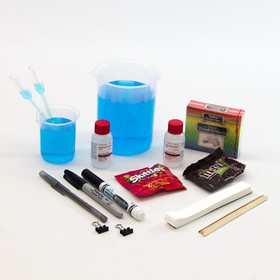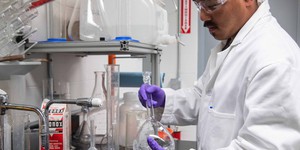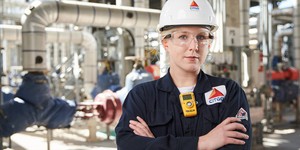Abstract
Did you know that mixtures can be unmixed? Chromatography is an analytical technique in chemistry to separate mixtures and identify each of its individual compounds. In this project, you will separate ink dyes found in different markers using a strip of paper, chalk and different liquids. By comparing different chromatography substrates and solvents, you will learn how different attractive forces between substances can affect the separation of a mixture into its individual components.Summary
Editor: Andrew Olson, Science Buddies
Edited by Svenja Lohner, PhD, Science Buddies
Objective
The objective of this project is to compare different chromatography substrates and solvents to see which combination performs best for separating ink components.Introduction
Matter makes up everything in the universe. Our body, the stars, computers, and coffee mugs are all made of matter. There are three different types of matter: solid, liquid, and gas. Matter is often a mixture of different substances. A heterogeneous mixture is when the mixture is made up of parts that are dissimilar (sand is a heterogeneous mixture). Homogeneous mixtures (also called solutions) are uniform in structure (milk is a homogeneous mixture). A sugar cube floating in water is a heterogeneous mixture, whereas sugar dissolved in water is a homogeneous mixture. In a mixture, the substance dissolved in another substance is called the solute. The substance doing the dissolving is called the solvent. If you dissolve sugar in water, the sugar is the solute and the water is the solvent.
In this project, you will be using paper chromatography to unmix the individual components of marker ink. To learn more about paper chromatography, you can continue reading and/or watch the video. The video gives an overview of what paper chromatography is, shows how it is done, explains the separation processes involved, and also provides tips and tricks for troubleshooting your experiment.
As mentioned in the video above, chromatography is a technique, that is used to separate the various components in a complex mixture or solution. In each chromatography apparatus there is generally a mobile phase, which is a fluid that runs along the stationary phase, and a stationary phase, that stays stationary while the mobile phase moves through. You will be making a small spot with an ink marker onto a strip of paper. The bottom of this strip will then be placed in a dish of water, and the water will soak up into the paper. The water is the mobile phase of the chromatography system, whereas the paper is the stationary phase. These two phases are the basic principles of chromatography. Chromatography works by something called capillary action. The attraction of the water to the paper (adhesion force) is larger than the attraction of the water to itself (cohesion force), hence the water moves up the paper. The ink will also be attracted to the paper, to itself, and to the water differently, and thus a different component will move a different distance depending upon the strength of attraction to each of these objects, as shown in Figure 1. As an analogy, let's pretend you are at a family reunion. You enjoy giving people hugs and talking with your relatives, but your cousin does not. As you make your way to the door to leave, you give a hug to every one of your relatives, and your cousin just says "bye." So, your cousin will make it to the door more quickly than you will. You are more attracted to your relatives, just as some chemical samples may be more attracted to the paper than the solvent, and thus will not move up the solid phase as quickly. Your cousin is more attracted to the idea of leaving, which is like the solvent (the mobile phase).
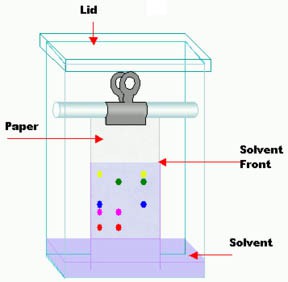 Image Credit: Wikipedia / Open source
Image Credit: Wikipedia / Open sourceA homemade paper chromatography testing box is made from a tall box with a lid. A dowel spanning the width of the box is placed near the top to allow a binder clip to hold a paper strip that has been marked by colored pigments. The paper strip is long enough to reach the bottom of the box where there is a small pool of solvent. As the solvent is absorbed by the paper and moves upward it brings some of the colored pigment markings with it.
Figure 1. Paper chromatography. Molecules are separated from each other, depending on how fast they migrate with the solvent up the chromatography paper. (Wikipedia, 2008.)
In paper chromatography, you can see the components separate out on the chromatography paper and identify the components based on how far they travel. To do this, we calculate the retention factor (Rf value) of each component. The Rf value is the ratio between how far a component travels and the distance the solvent (mobile phase) travels from a common starting point (the origin). For example, if one of the sample components moves 2.5 centimeters (cm) up the paper and the solvent moves 5.0 cm, as shown in Figure 2 below, then the Rf value is 0.5. You can use Rf values to identify different components as long as the solvent, temperature, pH, and type of paper remain the same. In Figure 2, the light blue shading represents the solvent and the dark blue spot is the colored solution sample.
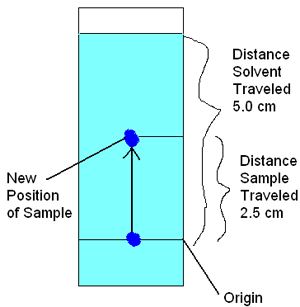
Diagram of a paper chromatography strip shows how marker ink travels up the length of a paper strip when the strip absorbs a liquid solvent. An origin line marks the original position of the ink and the solvent is colored blue so the distance the solvent travels up the paper strip can be measured. In the diagram, solvent traveled 5 centimeters, while the sample traveled 2.5 centimeters from the origin line.
Figure 2. For each compound, an Rf value is calculated based on how far it traveled along the stationary phase. In paper chromatography, Rf values are used to compare different components to each other.
Rf values are calculated by looking at the distance each component travels on the chromatography paper compared to the distance traveled by the solvent front. This ratio will be different for each component due to its unique chemical properties.
When measuring the distance the component traveled, you should measure from the origin (where the middle of the spot originally was) and then to the center of the spot in its new location. To calculate the Rf value, we then use Equation 1 below.
Equation 1:
In our example, this would be:
Note that an Rf value has no units because the units of distance cancel.
Polarity has a huge affect on how attracted a chemical is to other substances. Some molecules have a positively charged side and a negatively charged side, similar to a magnet. The positive side is attracted to the negative side of another molecule (opposites attract), and vice versa. The larger the charge difference, the more polar a molecule is. The reason for the unequal charge is that electrons (which are negatively charged) are not shared equally by each atom (in water, the negative electrons are more attracted to the oxygen because of its atomic structure). Some molecules, like vegetable oil, are neutral and do not have a charge associated with them; they are called nonpolar molecules. Polarity affects many of a molecule's properties, such as its affinity to water. Water is a highly polar molecule, so other polar molecules are easily attracted to it. A molecule is called hydrophilic if it dissolves well in water (hydrophilic essentially means "loves water"). A nonpolar molecule, such as oil, does not dissolve well in water, and thus it is hydrophobic ("fears water"). Oil would rather stick to itself than to water, and this is why it forms a layer across water instead of mixing with it. In chromatography, the polarity of the solvent determines how strongly the individual components of the mixture are attracted to the mobile phase versus the stationary phase. Therefore, the separation process will be dependent on the polarity of both phases.
Figure 3 below shows water molecules bonding with one another (hydrogen bonding). The negatively charged oxygen atom (red) on one water molecule is attracted to the positively charged hydrogen atom (white) on another water molecule.
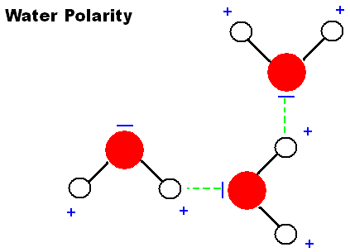
Molecules of water are made of a single oxygen atom and two hydrogen atoms. Oxygen atoms have a negative charge and hydrogen atoms have a positive charge. Hydrogen bonds can form between the hydrogen and oxygen atoms of different water molecules.
Figure 3. Hydrogen bond formation between two adjacent water molecules.
Figure 4 shows a fatty acid (a component of fat molecules) bonding with water. The hydrophobic tail is not attracted to the water, and thus it stands upright out of the water. The hydrophilic head is attracted to the water, which bonds to it. Many fatty acid molecules bonded together can form a layer above the water. Carbon atoms are represented by black circles.
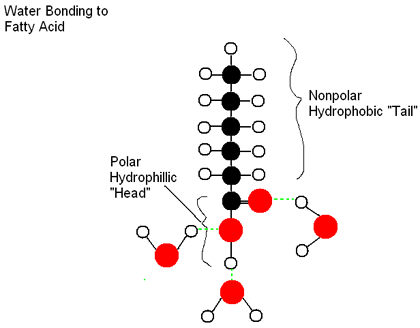
The head of a fatty acid molecule can create a hydrogen bond with water molecules. Hydrogen can bond to carbon atoms in the fatty acid and subsequent oxygen atoms in water can bond to the hydrogen attached to the carbon.
Figure 4. Hydrogen bond formation between a fatty acid molecule and a water molecule.
Chromatography is used in many different industries and labs. The police and other investigators use chromatography to identify clues at a crime scene like blood, ink, or drugs. More accurate chromatography in combination with expensive equipment is used to make sure a food company's processes are working correctly and they are creating the right product. This type of chromatography works the same way as regular chromatography, but a scanner system in conjunction with a computer can be used to identify the different chemicals and their amounts. Chemists use chromatography in labs to track the progress of a reaction. By looking at the sample spots on the chromatography plate, they can easily find out when the products start to form and when the reactants have been used up (i.e., when the reaction is complete). Chemists and biologists also use chromatography to identify the compounds present in a sample, such as plants.
In this science project, you will explore how the use of different stationary and mobile phases can affect the separation of marker ink. You will use chalk, chromatography paper, isopropyl alcohol, acetone, turpentine, and water. Which combination of these results in the best unmixing of marker ink?
Terms and Concepts
- Heterogeneous mixture
- Homogeneous mixture
- Solute
- Solvent
- Paper chromatography
- Mobile phase
- Stationary phase
- Capillary action
- Adhesion force
- Cohesion force
- Rf value
- Polarity
- Hydrophilic
- Hydrophobic
Questions
- How does the polarity of a substance affect how far it travels up the chalk/paper?
- Are the polarities of the chalk and the paper different? If yes, how will this affect the spreading of the different inks?
Bibliography
Here are some basic chemistry and chromatography resources:- Vartak, R.R. (2001, May). Chromatography: An Educational Tool.. Retrieved May 28, 2014.
- Carpi, Anthony, Ph.D. (2003). Chemical Bonding. Visionlearning. Vol CHE-1 (7). Retrieved March 18, 2013.
- Clark, Jim. (2007). Paper Chromatography. Retrieved March 18, 2013.
- Science Buddies. (n.d.). Paper Chromatography Resources. Retrieved January 14, 2018.
- Waters Corporation Staff. (2012). High Performance Liquid Chromatography. Retrieved November 29, 2012.
Materials and Equipment 
Recommended Project Supplies
- Candy Chromatography Science Kit, available from our partner
Home Science Tools.
You will need these items from the kit:
- Chromatography paper strips. The kit comes with 20 strips; additional chromatography paper can be purchased separately from our partner Home Science Tools.
- 90% isopropyl alcohol
- 100 mL beaker
- Mini binder clips (2)
- Wooden splints
- Different types of black markers (including a permanent marker)
- Note: This kit contains additional items to do other chromatography science projects. See the kit instructions page for details. Downloadable materials safety data sheets (MSDS) are available for all kit chemicals if required by your science fair.
- You will also need to gather these items, not included in the kit:
- Water
- Acetone (nail polish remover) or turpentine
- At least 30 pieces of thin chalk (same size)
- Ruler
- Pencils
Disclaimer: Science Buddies participates in affiliate programs with Home Science Tools, Amazon.com, Carolina Biological, and Jameco Electronics. Proceeds from the affiliate programs help support Science Buddies, a 501(c)(3) public charity, and keep our resources free for everyone. Our top priority is student learning. If you have any comments (positive or negative) related to purchases you've made for science projects from recommendations on our site, please let us know. Write to us at scibuddy@sciencebuddies.org.
Experimental Procedure
Separating the Ink Components
Note: To make sure you can compare your results, as many of your materials as possible should remain constant. This means that the temperature, brand of solvents used, size of paper strips/chalk, where the ink is placed onto the chalk/paper etc. should remain the same throughout the experiment.- Take a piece of chalk and etch a small ring two cm from the end.
- Take the black marker and thinly trace inside of the etched ring.
- Pour a small amount of your your first solvent (water) into the 100 mL beaker.
- Place the chalk upright in the beaker with the ink on the bottom (the ink should be above the solvent level, it must not be submerged or touching the liquid).
- Let the solvent rise up the chalk until it is almost at the top.
- Remove the chalk from the dish and mark how far the solvent rose with a pencil.
- Analyze the separated ink components.
- Measure the distance the solvent and each ink component traveled from the starting position, then calculate the Rf value for each component. (If there are not different colors in the ink, you should use a different marker.)
- Repeat the experiment for each brand of marker three times.
Changing the Stationary and Mobile Phase
Note: Using your knowledge of polarity and the results from your first trial for this marker brand, predict the order this ink will separate for each solvent and stationary phase.- Repeat the experiment, but instead of water, use a different mobile phase, such as isopropyl alcohol, nail polish remover, or turpentine. Again, repeat the chromatography procedure for each solvent and marker three times.
- Next, repeat the experiment with paper as stationary phase instead of chalk. Instead of etching into the paper, use a ruler and pencil to draw a line across it horizontally two cm from the bottom. Place a small dot of ink onto the line. Then use the mini binder clips and wooden splints to hang the paper strip into the beaker of solvent so it is barely touching. For more details on how to do this, see Paper Chromatography: Is Black Ink Really Black?
- Experiment with different combinations of stationary and mobile phases. Which combination results in the best separation?
Questions
For all of these questions, be sure to consider molecular structures and polarity.
- Which ink components were the most polar for each brand? Least polar? How do you know?
- How did the separation order differ for each solvent system, marker brand, and solid phase? Why?
- How did the Rf values differ for each solvent system, maker brand and solid phase? Why?
- Which combination of solid phase and solvent separated out each brand of marker the best?
- Were your initial predictions correct?
http://www.ias.ac.in/resonance/Volumes/06/05/0083-0091.pdf
Ask an Expert
Variations
- It is very easy to make this project more advanced without doing much additional work. You could test how changing the pH of the water and/or changing the temperature of the solvents affects your results. For changes in temperature, do a few levels of temperature difference: refrigerated, room temperature, and warm (do not let the solvents get so hot they boil). Changing the level of pH is easy, just add a small amount of acid (diluted hydrochloric or sulfuric acid will work). Test the pH of the water with litmus paper, and try a variety of different acidic pHs (maybe a pH of 2, 4, and 7). What is pH? Look here:
http://www.chem4kids.com/files/react_acidbase.html - Instead of analyzing different inks, you could analyze the compounds found in a plant; see:
Discover Chlorophyll Variety in Different Plants Using Paper Chromatography - For a more basic chromatography project, see:
Paper Chromatography: Is Black Ink Really Black?
Careers
If you like this project, you might enjoy exploring these related careers:
Contact Us
If you have purchased a kit for this project from Science Buddies, we are pleased to answer your questions.In your email, please follow these instructions:
- What is your Science Buddies kit order number?
- Please describe how you need help as thoroughly as possible:
Examples
Good Question I'm trying to do Experimental Procedure step #5, "Scrape the insulation from the wire. . ." How do I know when I've scraped enough?
Good Question I'm at Experimental Procedure step #7, "Move the magnet back and forth . . ." and the LED is not lighting up.
Bad Question I don't understand the instructions. Help!
Good Question I am purchasing my materials. Can I substitute a 1N34 diode for the 1N25 diode called for in the material list?
Bad Question Can I use a different part?
Contact Us
Related Links
- Science Fair Project Guide
- Other Ideas Like This
- Chemistry Project Ideas
- My Favorites
- Chemistry Safety Guide
- Visualizing Molecules in Three Dimensions




